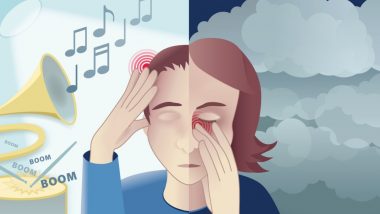Today is World Brain Day 2019. Every year, on July 22, the day is observed to promote an interest in neurology and brain studies by the World Federation of Neurology and International Headache Society. This year’s theme is Migraine: The Painful Truth. World Brain Day this year is dedicated to one of the commonest, debilitating illnesses in the world today. Migraine can be described as an intense, pounding ache in the head, characterised by a sectional headache, auras, extreme sensitivity to light and sound, nausea, fatigue and vomiting. Often, people who suffer from migraine are mistaken to be suffering from a simple headache. But there’s a world of difference between the two. Home Remedy of the Week: How to Treat Migraine Naturally with Ice Cream.
What is a Headache?
Headaches are quite common and are easily managed. According to Harvard Health, three out of every four adults face tension headaches. They are mild to severe and can occur on both sides of your head. Some headaches can be short-lived, others can last for a week. Here are the symptoms:
• Pain on both sides of the head
• Mild, bearable pain
• Vice-like tightening or squeezing pain instead of throbbing
• Sore temples
Types of headache include cluster headache, tension headache, sinus headaches, Chiari headache, medication headache, ice cream headache, high blood pressure headache and thunderclap headache.
What is a Migraine?
Migraine more intense and complex than regular headaches. It is a throbbing, pulsating pain in the head, characterised by other accompanying features. These include:
• Throbbing pain
• Pain in one side of the head
• Pain behind the eyes
• Spots or squiggly lines in front of the eyes
• Sensitivity to bright lights
• Sensitivity to loud sounds
• Vision loss
• Nausea
• Vomiting
• Stiff neck
A quick mnemonic POUND explains all the migraine symptoms – P- Pulsating Pain, O - One-day duration, U - Unilateral pain, N- Nausea and D - Disabling pain. Migraine Three Times More Common in Women Due to Higher Prevalence of Sex Hormones: Study.
If you see these symptoms, you are most likely to be suffering from migraine not headache. Triggers of migraine include:
• Emotional stress
• Heat
• Missing meals
• Changing weather
• Chocolate
• Cheese
• Wine
• Cured meats
• MSG
• Loud noise
• Strong smells
Migraines occur less frequently than normal headaches, but they can be more intense. Commonly, women are more at risk than men and the risk runs in the family. The workings of migraine are poorly understood by medical science. But according to neurologists, migraines are primarily caused by changes in the flow of blood of the brain and neural activities.
People who experience migraines find their quality of life profoundly affected. Mental health problems such as depression, anxiety and sleep disturbances are common in people with the condition. Hence it’s wrong to compare migraine to headache, which is less debilitating.
(The above story first appeared on LatestLY on Jul 22, 2019 05:29 PM IST. For more news and updates on politics, world, sports, entertainment and lifestyle, log on to our website latestly.com).













 Quickly
Quickly


